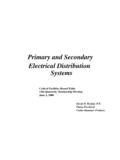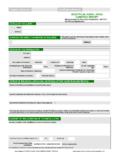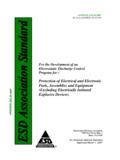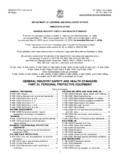Transcription of IEC 62353: Standards for the Safety and Efficacy of ...
1 2013 Dranetz Technologies 800-372-6832 ( & Canada) +1-732-287-3680 (International) IEC 62353: Standards for the Safety and Efficacy of Medical Electrical Equipment Introduction It might, perhaps, be a little too self-evident to say that there is no industry that is expected to require higher Standards for Safety procedures than the medical industry. The unbridled advancement of modern medicine has made hospitals and other medical facilities into one of the culture s paramount embodiments of a safe haven; between the extraordinary life-saving skills of the staff, the particular assistances received during times of crisis, and the remarkably powerful equipment, these facilities have come to rise even above their designed functionalities as symbols of how much their communities value human life and health.
2 But as mankind s capabilities progress, so too do his machines, presenting new complexities to the system, and with them, newer and greater dangers. Most of the individuals passing through these medical facilities do so with little, if any, thought about the proceedings that protect them from potential harm by way of technical malfunction; it is therefore feasible to declare that the standard procedures of maintenance of these medical electrical devices and the professionals who perform them are among the great unsung heroes of the general public.
3 The International Electrotechnical Commission, or IEC, has done the industry a great service by introducing a series of Standards for the Safety and Efficacy of medical electrical equipment, better known as IEC 60601. As IEC 60601 was put into practice, though, experts observed that these Standards overlooked the necessity of ongoing testing of the equipment after it had entered the field. Thus, a new set of Standards for this very purpose was introduced: IEC 62353. About This article was written to correspond with an article titled Testing Electrical Medical Devices IEC 62353, written by Mr.
4 Dieter Feulner, GMC-I Product Manager. Mr. Feulner is a German national expert and Member of IEC TC 62A WG 14, IEC 62353, as well as a German national expert and Member of IEC TC 85 WG 8, and IEC 61557. IEC 60601 vs. IEC 62353 IEC 60601, Medical Electrical Equipment General Requirements for Safety was introduced in 1977 and put forth a set of requirements for the manufacturers of medical equipment. These requirements were designed to detect and eradicate any potential electric hazards presented by the equipment being produced ( leakage currents, protective grounding, etc.)
5 Assuming the equipment was utilized properly for the duration of its lifespan, these tests were meant to curb possible defects later on. They were further utilized on equipment already in service as a means of routine tests and after-repair tests; however, this practice presented some unforeseen difficulties. For example, IEC 60601 outlines type-testing in laboratory conditions, but often those conditions are not available or applicable once the device is already in use. And so, thirty years after IEC 60601 appeared on the scene, in 2007, IEC 62353, Medical Electrical Equipment Recurrent Test and Test After Repair of Medical Electrical Equipment emerged to accommodate the needs of in-service devices.
6 IEC 62353 is specifically designed around testing equipment in the field, and is therefore more practical, more effective, and more safe than using IEC 60601 in those particular circumstances. 2013 Dranetz Technologies 800-372-6832 ( & Canada) +1-732-287-3680 (International) What, When, Who, How What is an electrical medical device? An electrical medical device is a device (including its application parts) connected to a particular mains supply of power that uses the transfer of energy to or from the patient or displays an energy transfer of this sort in order to diagnose, treat, or monitor the patient.
7 Electrical medical devices are often combined into systems, and these systems can be tested just like devices. The IEC 62353 standard only applies to electrical medical devices or systems and their components that comply with IEC 60601. All devices within a certain proximity of the patients must also comply with IEC 62353 Standards . When are the tests specified by IEC 62353 performed? IEC 62353 requires testing before initial start-up, after repair, and periodically. The manufacturer is obligated to provide information about the testing of the device, with which the operator of the testing should carefully comply.
8 Who should perform these tests? Tests of device Safety must be performed by qualified electricians who have received adequate training for attending to devices under testing conditions. Qualified in this case is defined as including technical training, knowledge and practical experience, and keen awareness and familiarity of all relevant technologies, Standards , and local regulations. Individuals who perform Safety tests must be able to recognize any threats posed by devices that do not meet Safety Standards .
9 Please take note that most of those individuals who are qualified for testing devices are not necessarily qualified for testing systems, and that testing systems requires additional test instruments. If the Safety of the device while it is being tested cannot be assured, it must be accordingly identified, and the responsible organization must be notified in writing of the resultant hazard. How is testing performed? Before testing, accompanying documentation must be examined, and accordingly, manufacturer recommendations of maintenance and repair taken into account.
10 Whenever and wherever possible, the device must be disconnected from the mains supply power; otherwise, special measures must be implemented for the prevention of hazards resulting from working on live devices. Documentation All tests carried out must be documented in depth. Testing documents must at the very least contain the following entries: Designation of the test location ( company, department, authority) Name of the person(s) who performed and evaluated the test Designation of the tested device and accessories ( type, serial number, inventory number) Executed tests including measured values, measuring methods and utilized measuring instruments Function test Final evaluation Date and ignature of the person who prepared the evaluation Identification of the tested device (if required by the operating service provider)







